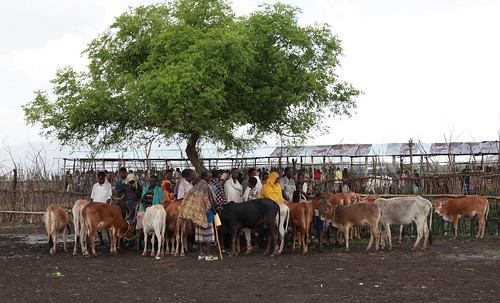 |
| Cattle market in Mi'eso, Oromia Region, Ethiopia (photo credit: ILRI/Apollo Habtamu). |
Despite the prominence of cattle in Ethiopian society and its economy, relevant qualitative and quantitative
information is both scarce and subject to a variety of interpretations.
Mobilizing cattle, and their supporting natural and human resource base, in a sustainable manner for development purposes is therefore a challenge that begins with identification of problems and opportunities about which there is limited agreement.
It is in this context that the Government of Ethiopia requested a diagnostic study, through the Bill & Melinda Gates Foundation, which is supporting the Ethiopian Ministry of Agriculture and Rural Development to undertake a work program requested by the government, to provide strategic input and technical assistance in several key areas of the country’s agricultural sector.
Using an extensive review of secondary materials, learning from a series of stakeholders’ consultations, and participatory rapid assessments of market actors, the study analyzed live cattle and beef marketing.
The key findings have been published by the International Livestock Research Institute (ILRI) in a discussion paper.
The rapid appraisal focused on two of Ethiopia’s major cattle trading routes, representing each of the agropastoral highland production systems and pastoral lowland production, and the respective routes taken by animals to market.
The main objective was to diagnose problems based on quantitative measures, and identify associated policy strategies. The study team included local specialists, international management consultants, as well as researchers from CGIAR.
The team not only interacted with the policymakers on emerging results but also triangulated the results with other experts in the country in the forms of both stakeholders’ consultations and one-to-one interviews.
Download the discussion paper
Citation
GebreMariam S, Amare S, Baker D, Solomon A and Davies R. 2013. Study of the Ethiopian live cattle and beef value chain. ILRI Discussion Paper 23. Nairobi, Kenya: ILRI.
Mobilizing cattle, and their supporting natural and human resource base, in a sustainable manner for development purposes is therefore a challenge that begins with identification of problems and opportunities about which there is limited agreement.
It is in this context that the Government of Ethiopia requested a diagnostic study, through the Bill & Melinda Gates Foundation, which is supporting the Ethiopian Ministry of Agriculture and Rural Development to undertake a work program requested by the government, to provide strategic input and technical assistance in several key areas of the country’s agricultural sector.
Using an extensive review of secondary materials, learning from a series of stakeholders’ consultations, and participatory rapid assessments of market actors, the study analyzed live cattle and beef marketing.
The key findings have been published by the International Livestock Research Institute (ILRI) in a discussion paper.
The rapid appraisal focused on two of Ethiopia’s major cattle trading routes, representing each of the agropastoral highland production systems and pastoral lowland production, and the respective routes taken by animals to market.
The main objective was to diagnose problems based on quantitative measures, and identify associated policy strategies. The study team included local specialists, international management consultants, as well as researchers from CGIAR.
The team not only interacted with the policymakers on emerging results but also triangulated the results with other experts in the country in the forms of both stakeholders’ consultations and one-to-one interviews.
Download the discussion paper
Citation
GebreMariam S, Amare S, Baker D, Solomon A and Davies R. 2013. Study of the Ethiopian live cattle and beef value chain. ILRI Discussion Paper 23. Nairobi, Kenya: ILRI.
